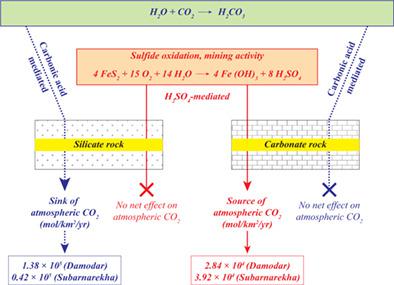当前位置:
X-MOL 学术
›
Hydrol. Process.
›
论文详情
Our official English website, www.x-mol.net, welcomes your feedback! (Note: you will need to create a separate account there.)
Major ion chemistry of two cratonic rivers in the tropics: Weathering rates and their controlling factors
Hydrological Processes ( IF 3.2 ) Pub Date : 2021-01-06 , DOI: 10.1002/hyp.14035 Anupam Samanta 1 , Gyana Ranjan Tripathy 1 , T. Aswin Pradeep 1, 2 , Anirban Mandal 1
Hydrological Processes ( IF 3.2 ) Pub Date : 2021-01-06 , DOI: 10.1002/hyp.14035 Anupam Samanta 1 , Gyana Ranjan Tripathy 1 , T. Aswin Pradeep 1, 2 , Anirban Mandal 1
Affiliation

|
Continental weathering plays a dominant role in regulating the global carbon cycle, soil chemistry and nutrient supply to oceans. The CO2‐mediated silicate weathering acts as a major CO2 sink, whereas sulphuric acid‐mediated carbonate dissolution releases CO2 to the atmosphere–ocean system. In this study, dissolved major ions and silica concentrations of two tropical (Damodar and Subarnarekha) river systems from India have been measured to constrain the type and rate of chemical weathering for these basins. The total dissolved solids (TDS) of these rivers, a measure of total solute supply from all possible sources, are about 2–3 times higher than that of the global average for rivers. Mass balance calculations involving inverse modelling estimate that 63 ± 11% of total cations are derived from rock weathering, of which 27 ± 7% of cations are supplied through silicate weathering. The sulphide‐S concentrations are estimated by comparing the water chemistry of these two rivers with that of a nearby river (Brahmani) with similar lithology but no signatures of sulphide oxidation. The outflows of Damodar and Subarnarekha rivers receive 17% and 55% of SO4 through sulphide oxidation, respectively. The sulphide oxidation fluxes from the ore mining areas, such as upper Damodar (0.52 × 109 mol/yr) and lower Subarnarekha (0.66 × 109 mol/yr) basins, are disproportionally (~9 times) higher compared to their fractional areal coverage to the global drainage area. The corresponding CO2 release rate (2.84 × 104 mol/km2/yr) for the Damodar basin is lower by five times than its CO2 uptake rate (1.38 × 105 mol/km2/yr). The outcomes of this study underscore the dominance of sulphide oxidation in controlling the dissolved chemical (cationic and sulphur) fluxes.
中文翻译:

热带两条克拉通河的主要离子化学性质:风化率及其控制因素
大陆风化在调节全球碳循环,土壤化学和海洋养分供应方面起着主导作用。CO 2介导的硅酸盐风化作用是主要的CO 2汇,而硫酸介导的碳酸盐溶解释放出CO 2到大气-海洋系统。在这项研究中,对来自印度的两个热带(Damodar和Subarnarekha)河流系统的溶解性主要离子和二氧化硅浓度进行了测量,以限制这些盆地的化学风化类型和速率。这些河流的总溶解固体(TDS)(衡量所有可能来源的总溶质供应)比河流全球平均水平高约2-3倍。涉及逆模型的质量平衡计算估计,总阳离子的63±11%来自岩石风化,其中27±7%的阳离子通过硅酸盐风化提供。通过比较这两条河流与附近具有相似岩性但无硫化物氧化特征的河流(布拉曼尼)的水化学性质,估算硫化物的浓度。4通过硫化物分别氧化。来自矿石开采区的硫化物氧化通量,例如上部的Damodar(0.52×10 9 mol / yr)和下部的Subarnarekha(0.66×10 9 mol / yr)盆地,与它们的部分面积相比,成比例地高(〜9倍)。覆盖全球流域。达莫达盆地的相应CO 2释放速率(2.84×10 4 mol / km 2 / yr)比其CO 2吸收率(1.38×10 5 mol / km 2 / yr)低五倍。这项研究的结果强调了硫化物氧化在控制溶解的化学(阳离子和硫)通量方面的优势。
更新日期:2021-02-25
中文翻译:

热带两条克拉通河的主要离子化学性质:风化率及其控制因素
大陆风化在调节全球碳循环,土壤化学和海洋养分供应方面起着主导作用。CO 2介导的硅酸盐风化作用是主要的CO 2汇,而硫酸介导的碳酸盐溶解释放出CO 2到大气-海洋系统。在这项研究中,对来自印度的两个热带(Damodar和Subarnarekha)河流系统的溶解性主要离子和二氧化硅浓度进行了测量,以限制这些盆地的化学风化类型和速率。这些河流的总溶解固体(TDS)(衡量所有可能来源的总溶质供应)比河流全球平均水平高约2-3倍。涉及逆模型的质量平衡计算估计,总阳离子的63±11%来自岩石风化,其中27±7%的阳离子通过硅酸盐风化提供。通过比较这两条河流与附近具有相似岩性但无硫化物氧化特征的河流(布拉曼尼)的水化学性质,估算硫化物的浓度。4通过硫化物分别氧化。来自矿石开采区的硫化物氧化通量,例如上部的Damodar(0.52×10 9 mol / yr)和下部的Subarnarekha(0.66×10 9 mol / yr)盆地,与它们的部分面积相比,成比例地高(〜9倍)。覆盖全球流域。达莫达盆地的相应CO 2释放速率(2.84×10 4 mol / km 2 / yr)比其CO 2吸收率(1.38×10 5 mol / km 2 / yr)低五倍。这项研究的结果强调了硫化物氧化在控制溶解的化学(阳离子和硫)通量方面的优势。



























 京公网安备 11010802027423号
京公网安备 11010802027423号